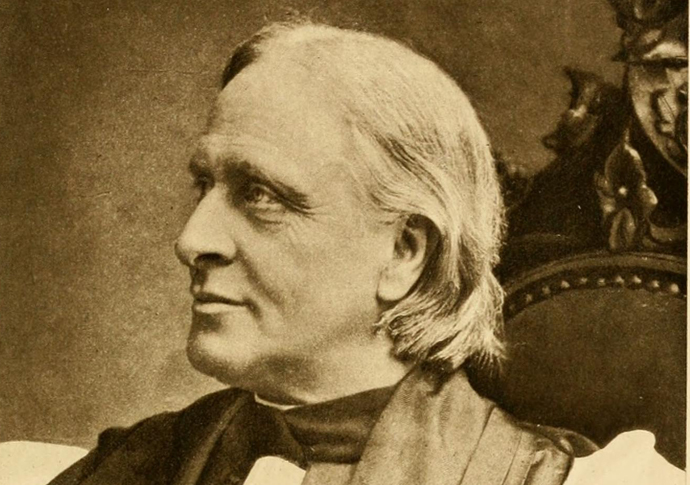How ‘God’s head waiter’ became Archbishop of Canterbury
In the latest in his series on eminent Victorians, Neil Titley turns his attention to a ruthless disciplinarian whose family life was... well, complicated
Friday, 24th October — By Neil Titley

Edward Benson
WITH the installation of Dame Sarah Mullally as the new Archbishop of Canterbury, the opportunity arises to look back at a previous occupant of the post.
Edward Benson (1829-1896), sometimes known as “God’s head waiter”, had displayed his leadership qualities during his previous career as headmaster of Rugby School and then Wellington College.
He was known to be such a ruthless disciplinarian that his thrashing of miscreants almost provoked a rebellion. One of Benson’s ex-pupils said that during a period of his school life he had four different colours of bruises on his body – purple, blue, green, kand yellow – as a result of Benson’s attentions.
Apparently, such savagery enhanced Benson’s career prospects, and in 1876 he became Bishop of Truro, where his authoritarian inclinations received a setback. One Cornish vicar especially irritated Benson as the man had never set foot in the parish church, let alone held a service in it. The cleric preferred to carry out his duties by occasionally wandering down to the garden gate of the vicarage “clad in a flowered dressing gown and smoking a hookah” and chatting amiably to any parishioner who happened to pass by.
To Benson’s intense annoyance he found that he had no ecclesiastical power to remove the man.
In 1882 Edward fulfilled his ambitions by becoming Archbishop of Canterbury and inventing the Christmas service of Nine Lessons and Carols.
He also enjoyed ghost stories and suggested a plot to the novelist Henry James. James liked the idea and published it a year later under the title The Turn of the Screw. It was filmed in 1961 as The Innocents.
When he was aged 23, the future archbishop proposed to Minnie Sidgewick but as she was only 11 years old at the time, they delayed the wedding for seven years.
After the marriage, Minnie gave birth to six children, (the eldest boy, Martin, died aged 17).
The most famous of his children was the writer EF Benson (known as “Fred”). A discreet homosexual, he published the lastingly popular Mapp and Lucia series of novels. Latterly, he lived in Lamb House in Rye, Sussex (Henry James’s old residence) and in 1933 was elected 645th Mayor of Rye.
During his youth, Fred went to Greece and spent much of the 1890s as an archaeologist based in Athens. After the Greek army had been comprehensively beaten in the Greco-Turkish War of 1897, Fred visited the ravaged region of Thessaly and reported one embarrassing incident that had occurred during the Greek defeat.
When the first modern Olympic Games had taken place in Athens in the previous year, the main event, the Marathon, had been won by a Greek runner called Loues. Loues received the plaudits of the nation for his achievement, one of his rewards being the promise of a free dinner every night for the rest of his life. As the Greek army collapsed a year later, the troops scattered in terror and fled. Having been able to outrun the rest of the army, the first man to arrive back in Athens was Loues. It was the end of the free dinners.
The archbishop’s eldest surviving son was Arthur Benson who became the Master of Magdalene College, Cambridge and the writer of the lyrics to Land of Hope and Glory. He was known for his aversion to women and apparently remained a lifelong virgin.
Hugh Benson was the youngest member of the family and also shunned female company. He became an Anglican priest but shocked his circle by converting to Roman Catholicism.
After the relentless grind of maternity, Archbishop Benson’s wife Minnie became interested in other women, chief of whom was Lucy Tait. Her father Archibald had preceded Edward Benson as Archbishop of Canterbury from 1868 till 1882. Minnie and Lucy enjoyed sexual relations in the early days of their relationship and always shared the same bed. After Benson’s death in 1896 Minnie renamed herself “Ben” and regarded Lucy as a second husband.
Previously, Minnie had also been the lover of the notorious Dame Ethel Smyth.
Having seduced the mother, Ethel Smyth turned her attentions to Minnie’s elder daughter, Nellie. Although she had been involved in lesbian affairs previously at Oxford, Nellie’s main love affair before her early death aged 27 was with Smyth.
Moving on to Minnie’s other daughter, Maggie, Smyth swiftly seduced the girl. It was Maggie though who left Ethel behind in favour of a new love whom she met during a trip to Egypt. Maggie spent three years excavating the Temple of the Goddess Mut at Thebes, before becoming homicidally insane and ending her days in a mental institution.
It was ironic that, although an adherent of the sternest Victorian moral values himself, the Archbishop of Canterbury had created a family in which all five surviving children were either actively or latently homosexual, and a wife involved in a lesbian relationship with the daughter of the previous Archbishop of Canterbury.
• Adapted from Neil Titley’s book The Oscar Wilde World of Gossip. See www.wildetheatre.co.uk – available at Daunts, South End Green